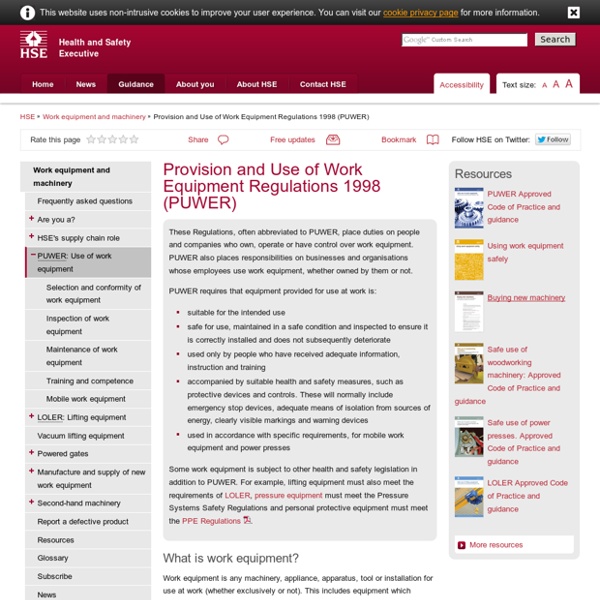Provision and Use of Work Equipment Regulations 1998 (PUWER) - Work equipment and machinery

Health and Safety at Work etc Act 1974 – legislation explained
The Health and Safety at Work etc Act 1974 (also referred to as HSWA, the HSW Act, the 1974 Act or HASAWA) is the primary piece of legislation covering occupational health and safety in Great Britain. The Health and Safety Executive, with local authorities (and other enforcing authorities) is responsible for enforcing the Act and a number of other Acts and Statutory Instruments relevant to the working environment. The full text of the Act (as amended) is available at legislation.gov.uk [1] where it can also be downloaded free of charge. Health and Safety at Work etc Act 1974 [2] This is the latest version. [3] website. Statutory instruments are pieces of secondary legislation made under specific Acts of Parliament. See Legislation enforced by HSE[4] for more details. If you need further advice on legal matters concerning the workplace, please consult Sources of information and external advisory services[5]. You can also seek independent legal advice.
RIDDOR
Deaths and injuries If someone has died or has been injured because of a work-related accident this may have to be reported. Not all accidents need to be reported, other than for certain gas incidents, a RIDDOR report is required only when: the accident is work-related[1] it results in an injury of a type which is reportable Types of reportable injury The death of any person All deaths to workers and non-workers, with the exception of suicides, must be reported if they arise from a work-related accident, including an act of physical violence to a worker. Specified injuries to workers The list of ‘specified injuries’ in RIDDOR 2013 replaces the previous list of ‘major injuries’ in RIDDOR 1995. For further guidance on specified injuries[2] is available. Over-seven-day incapacitation of a worker Over-three-day incapacitation Accidents must be recorded, but not reported where they result in a worker being incapacitated for more than three consecutive days. Occupational diseases Dangerous occurrences
EPA
The United States Environmental Protection Agency[2] (EPA or sometimes USEPA) is an agency of the U.S. federal government which was created for the purpose of protecting human health and the environment by writing and enforcing regulations based on laws passed by Congress.[3] The EPA was proposed by President Richard Nixon and began operation on December 2, 1970, after Nixon signed an executive order. The order establishing the EPA was ratified by committee hearings in the House and Senate.[4] The agency is led by its Administrator, who is appointed by the president and approved by Congress. The current administrator is Gina McCarthy.[5] The EPA is not a Cabinet department, but the administrator is normally given cabinet rank. The agency has approximately 15,193 full-time employees [6] and engages many more people on a contractual basis. Closeup of EPA building History[edit] Stacks emitting smoke from burning discarded automobile batteries, photo taken in Houston in 1972 by Marc St.
COSHH
Where a person suffers damage caused by a breach of a duty imposed by regulations, they have a cause of action in tort against the offender.[8] The Control of Substances Hazardous to Health (COSHH) regulations have been in place for more than 20 years and the scientific evidence suggests that over this time industry has, in general, been consistently reducing exposure to hazardous substances. European Legislation implemented[edit] The regulations implement the following European Union (EU) directives:[2] The regulations are consistent with Commission Directive 91/322/EEC requirements on indicative limit values.[2] Prohibited substances[edit] Import prohibited[edit] Import is prohibited into the UK, other than from another EU member state or member of the European Economic Area, of (reg.4(2)): Contravention is an offence under the Customs and Excise Management Act 1979 rather than health and safety regulations. Supply prohibited[edit] Prohibited for specified purposes[edit] Exceptions[edit]
HASAWA
Related:
Related:



